Today, I would like to describe my favorite chromatographic books: from one I bought even before I (really) knew what chromatography is to one which has chapter with my name on it.
Úvod do vysokoúčinné kapalinové kolonové chromatografie
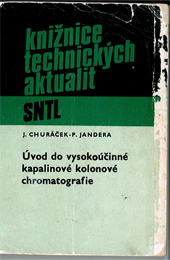
I am sorry to all of you who does not understand Czech language. This is my very first chromatographic book and I bought it even before I knew the term “chromatography” itself. The book was written by prof. Jandera and prof. Churacek and the name of the book in English means “Introduction to high performance liquid column chromatography“. The book was published in 1984.
It was on the end of my first year at university. I walked aimlessly through the library shop and in the corner I found shelf full of these books. They were already a little bit damaged and each one of them costs less than a big beer (which is actually the cheapest drink you can get in almost any restaurant in Czech Republic). I had no idea what chromatography means, who are the authors and what is going to be my main direction during years at university. So I bought it.
In couple of months I met chromatography again – during our analytical chemistry II lessons. In that time, I started slowly eplore the beauty of (liquid) chromatography separations and moved my attention from analysis of biological materials (which was my main direction) towards analytical chemistry itself and particularly liquid chromatography.
Later on, I was lucky enough to be part of the class when founder of chromatography techniques in Czech Republic – Prof. Churacek – gave lessons during his last year before retirement. So there is no surprise, that I asked Prof. Jandera if there is a space for me in his group – there was and since then I am part of his group at University of Pardubice, Czech Republic.
And the book I am talking about now was always with me, whenever I was working with chromatography abroad.
Actually, I have it on my desk even now.
HPLC Columns: Theory, Technology, and Practice
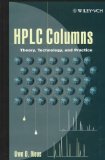
My second HPLC book in the list is HPLC Columns: Theory, Technology, and Practice written by Uwe Neue. This book describes thoroughly a theory of chromatography, columns packing, characterization, chemistry, selection, and maintenance. Large part of the book is devoted to individual modes of liquid chromatography, such as normal and reversed-phase, size-exclusion, hydrophilic interaction, and ion-exchange chromatography.
I still remember reading the parts about methacrylate-based packing, few paragraphs about monolithic stationary phases (page 72;) and trying to dip more and more in a liquid chromatography techniques and separations. Sweet first year of my PhD.
What I especially like on Uwe Neue’s book is its easy to read style and the way how he explains the problem. Reading the book I have feeling that I am on his lecture or (even better) listening to him.
Monolithic Materials: Preparation, Properties, and Applications
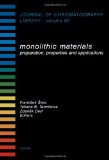
Bible of monoliths. Ok, let’s at least call it a fundamental book in area monolithic stationary phases edited by Frantisek Svec, Tatiana Tennikova and Zdenek Deyl. It took me while before I was able to look inside this very first book describing preparation, characterization and application of continuous porous stationary phases. Finally, I was able to borrow it from library of Eindhoven’s Technical University during my stay there. I immediately made a copy of first chapters focusing on organic polymer monoliths and read them the same evening.
There are two big advantages of this book: First, it was first. I don’t think I have to write more about it. Secondly, it describes the monolithic stationary phase from A to B. There is a description of all main types of monoliths, their preparation techniques, properties, and characterization: organic polymer-based monoliths, silica-based monoliths, ring-opening metathesis polymerization, water-soluble monomers-based monoliths, polysaccharide materials, and high internal phase emulsion materials, just to name a few.
Moreover, application description spans from separation of small molecules, through peptides and proteins to DNA and large polymer standards.
If you are new in a field of monolithic stationary phases, this book gives you nice overview of possible materials and their application in the separation you need.
Introduction to Modern Liquid Chromatography
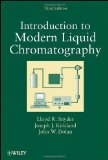
3rd edition of this introduction with almost 900 hundred pages covers probably all possible questions about theory of liquid chromatography and its application. Authors Lloyd R. Snyder, Joseph J. Kirkland and John W. Dolan focus on theory, instrumentation (detection, column, troubleshooting), method development and validation, and sample preparation. Of course, there is a deep description of individual modes of liquid chromatography, as in the case of Uwe Neue’s book: normal phase, reversed-phase, ion-exchange, size-exclusion, chiral separations, and preparative chromatography.
Individual chapters are divided according the type of sample and/or technique used. So, for example, you can find information about hydrophilic interaction chromatography (HILIC) as a part of chapter Normal phase chromatography as well as Separation of peptides and proteins.
Monolithic Chromatography and its Modern Applications
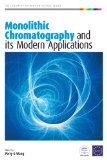
Reading all these books I always thought Maybe once I can have a chapter in such a book. And it happened. Roughly three years ago editor Perry Wang contacted Pavel Jandera with question about his contribution to book about monolithic stationary phases and its modern applications. We extended our review about polymethacrylate monoliths dedicated to Frantisek Svec on the occasion of his birthday and prepared chapter for forthcoming book.
In comparison to the first book I mentioned couple of paragraphs ago, this one does not cover such a broad range of different monolithic materials. It describes organic polymers, as well as silica-based monoliths, further ring-opening metathesis polymerization and monolithic cryogel beds.
The description of analysis of pharmaceutical-, ionic-, and phytochemicals, amino acids, and DNA and viruses separations is in an application part of the book.
I am especially looking forward to reading chapter about hyphenation of monolithic columns with chemiluminescence detection, because it reminds me time I spent in Paris working with supercritical fluid chromatography and chemiluminescence detection in analysis of crude oil residuals.

6 replies on “My HPLC books”
Practical HPLC Method Development, second edition by Synder, Kirkland and Glajch. I am more of the HPLC user type :)
I have read “Monolithic Chromatography and its Modern Applications” in books.google.com. But in this website i only read some pages, I really want to read full text. I really need your support in there. Could you send me pdf file of it?
Dear sir,
Could you provide me soft copy of the books entitled “HPLC Columns: Theory, Technology, and Practice”. I am very interested to read and understand this book.
Awaiting your positive reply.
Thanking you.
I am sorry, I dont have a soft copy of this book, you might check some of your local (university) library or buy a book at amazon